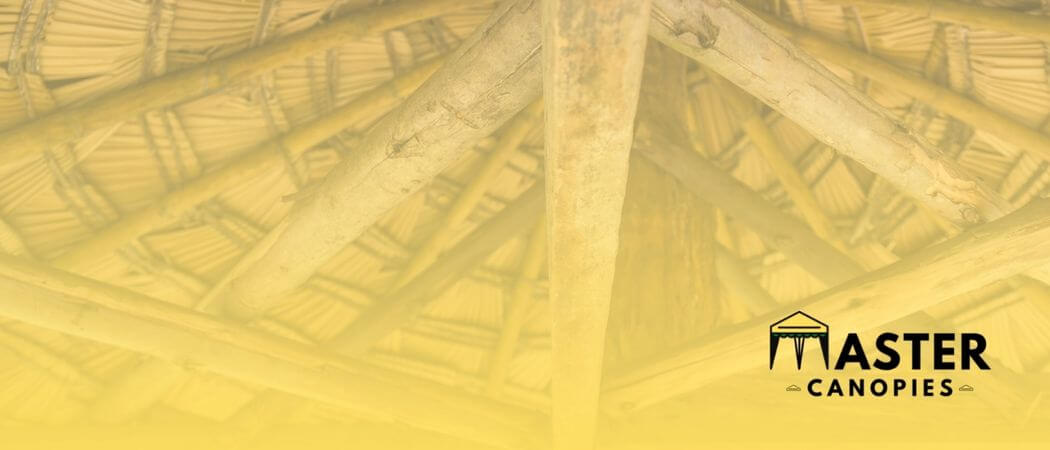
Pavilion vs Gazebo: Which is Superior to Buy?
Pavilion vs Gazebo: Which is Superior to Buy? Published November 11th, 2022 by Allen Campbell If you’re looking to add a backyard structure, you have
Published November 7th, 2022 by Allen Campbell

Whether you’re a first-time camper or an experienced outdoorsman, there’s no doubt that a good tent seam sealer is a must-have accessory. A quality sealant will keep your tent watertight and prevent pesky leaks, keeping you and your gear nice and dry.
With such a wide variety of seam sealers available, it can be tough to determine which one is best for your purposes. To make it easier on you, I’ve gathered a list of the current best tent seam sealers available. So read on to find out which products made the cut!

Gear Aid seam grip is a sealant and is the best tent seam sealer we know of that hardens quickly and can be used on different types of fabrics. Materials such as nylon, polyester, and canvas can all be treated with this sealant. This sealant only takes two hours to cure, so you won’t have to wait long to use your tent.
Additionally, this product can cover up and repair to 60 feet of seams, making it ideal for larger tents. With this product, you don’t have to worry about your tent getting ruined in bad weather– it’s waterproof and saltwater-resistant!
For easier application, the company has provided a soft brush on top of the bottle, which is designed to apply the sealer smoothly on the fabric. The only thing you need to do is just press and hold the brush on top of the can while you’re moving it along the seam. After application, this seam sealer will dry clear, so it won’t affect the look of your tent.
Also, the glossy finish it leaves on the tent’s fabric is barely noticeable and shouldn’t be a cause for concern. This product is perfect if you’re looking for an all-purpose seam sealer that dries quickly.

The Kenyon Seam Sealer is a great choice for a tent seam sealer and is made without any harmful chemicals, making it a safe choice for those with sensitivities. The included applicator makes things easier, but the sealer itself is quite thin and can be hard to work with. After applying the sealant perfectly, all the open holes and fabric will be sealed with an invisible and waterproof layer.
It’s perfect for those who want to protect their belongings from the elements without changing the look or feel of the material. This canopy tent seam sealer can be easily applied to any synthetic fabric, making it a versatile product for those with various tents. The clear coat will also prevent any future fraying or tearing, and extend the life of your tent dramatically.
You never have to worry about water getting in through the seams of your tent again with the Kenyon Seam Sealer. This product is a must-have for anyone who wants to keep their gear in good condition for years to come.
The heavy rainfall might have affected the sealant’s performance for some users. Take into account that you might need to apply more sealer than usual if you live in an area with a lot of rainfall. Other than that, the Kenyon Seam Sealer is a great product that does its job well.

Don’t let the small size of the GEAR AID seam sealant tube fool you – this product is powerful. You can easily seal 24 feet of seams with one tube. The silicone-based sealant is thick, but once you get the hang of it, it’s easy to apply. You will be amazed by the wind and waterproof seal it provides.
Whether you’re an experienced camper or a first-timer, this is the one product you need to make sure your gear stays in good condition. The flexible nature of this sealant will keep your gear from cracking and it can even withstand heavy rain and snow.
Perhaps the best feature of this product is that it’s clear, meaning it won’t ruin the look of your gear. According to my experience, the quantity in one tube is not sufficient for sealing a large tent. You might want to purchase two tubes, just to be on the safe side – and because it’s so affordable, it’s not a bad idea to have an extra one on hand, anyway.
Any material that has silicone seams will benefit from this product, including tents, tarps, rain gear, packs, and more. GEAR AID is the best seam sealant on the market, and it will last you a long time.

Unlike other sealant options, the Texsport Polyurethane Waterproof Seam Sealer is very easy to apply since it is a spray bottle. Just follow the instruction, and your tent will be well protected in no time. The best thing about this product is that it dries clear, so you won’t have to worry about changing the look of your gear.
The 48-hour drying process might seem like a long time, but it’s worth the wait. The flexibility and durability of the seal are second to none. You can even use this sealer on other materials like tarps, awnings, and rain gear. With this, you no longer have to stress about grime, water, or UV rays spoiling your equipment.
I would highly suggest applying a double coat for better protection, especially if you live in an area with a lot of rainfall.

Your large-size tent can easily be taken care of with Iosso seam sealer. This product will make your life easier with its 4 oz bottle and soft brush that makes applying the sealant a breeze. Compared to another model, this sealant is thin and runny, so it is easy to spread out. Be cautious when using this product near your gear.
After applying the proper amount of sealer and allowing it to dry, you will create an invisible waterproof barrier on your gear that will keep moisture out and any other element like dirt, dust, or debris. You won’t even notice the difference with your gear.
You can use it on any type of fabric like cotton, polyester, or synthetic. Iosso seam sealer works best on those materials. Moreover, it doesn’t produce a strong smell, so you can use without having to worry about the fumes. Your gear will be well-protected from the harmful chemicals, and you’ll also be safe.
Cons:
The thickness of the sealer is important because you don’t want it to be too runny. If it’s too thin, it won’t adhere to the fabric as well and might not provide adequate protection. However, if it is too thick, you will have a difficult time applying it smoothly and could end up damaging your tent.
So, in order to make the process and result as good as possible, look for a sealer that is of medium thickness. In the end, it should be easy to apply and result in a flexible, durable seal.
Nobody likes to wait for things to dry, but in this case, it’s worth it. And it is also important to note that different sealers have different drying times. Some can take up to 48 hours to completely dry, while others might only take a few hours. So, if you’re in a hurry, make sure to check the drying time before you buy.
Flexibility is another crucial factor to consider because you don’t want the sealer to make your gear stiff. A good seam sealer should be flexible enough to allow your gear to move and flex without cracking or breaking the seal.
A good seam sealer should be able to do more than just seal seams. It should also be able to protect other materials like tarps, awnings, and rain gear. So, if you can find a seam sealer that is multi-purpose, it will be worth the investment.
Tent seam sealers are a must-have for any camping trip. A good tent seam sealer will help to keep your canopy tent watertight and leak-free, so you can focus on enjoying your time in nature instead of worrying about the weather.
I’ve tested several different types of tent seam sealers and found the best ones on the market, so you can rest assured that your next camping trip will be a success. No matter what your needs are, one of these products is sure to fit the bill.
Anyone who has ever gone camping knows that one of the most important things is to make sure your tent is properly sealed. Otherwise, you run the risk of waking up in the middle of the night soaking wet from a rainstorm – not exactly the ideal camping experience. But when it comes to seam sealer, where exactly should it go? The answer may surprise you…it actually goes both ways!
But in general, most people put the seam sealer on the inside of their tents. That’s because it needs to be in direct contact with the seams in order to work properly. Also, the tent will look nicer from the outside if the seam sealer is on the inside. So next time you’re getting your tent ready for a camping trip, make sure to apply the seam sealer on the inside – and hopefully, you’ll stay dry all night long.
Seam sealer is essential for any tent owner. This clear, sticky substance is applied to the seams of the tent in order to prevent water from seeping in and ruining your camping trip. But how long does it take for the seam sealer to dry? However, many campers are surprised to learn that seam sealer can actually take several hours or even 1-2 days to completely dry.
In fact, it is advised by most manufacturers to allow the sealer ample time to cure- approximately 24 hours- before using the tent. Otherwise, the seals may not be fully effective and the tent could leak in wet weather. Of course, if you’re in a hurry, you can always try using a hair dryer to speed up the drying process. Keep the temperature low and hold the dryer around six inches away from the fabric. With a little patience, you’ll have a weatherproof tent in no time.
If you’ve ever worked with seam sealer, you know that it doesn’t exactly dry hard. In fact, it’s more like a thick, gloopy paste that never really sets up completely. So what’s the deal? Is seam sealer just a glorified version of Elmer’s glue? Not exactly. Seam sealer is designed to fill in the gaps between pieces of fabric, creating a waterproof barrier that will help keep your gear dry.
The key is to use just enough seam sealer to fill the gap without creating a big glob that will catch on everything and make a mess. Once you’ve got the right amount of seam sealer in place, it should dry to a flexible, rubbery consistency that will keep out water without being too stiff or brittle. So if you’re wondering whether seam sealer dries hard, the answer is: sort of.

Allen is a full time writer at Mastercanopies.com and enjoys traveling around the United States and exploring nature. He enjoys writing about canopies as he believes they are extremely crucial in having a successful camping trip whether it be a trip to the beach, mountains, or the open plains.

Pavilion vs Gazebo: Which is Superior to Buy? Published November 11th, 2022 by Allen Campbell If you’re looking to add a backyard structure, you have

Canopy vs Gazebo: Which are Better and What are the Differences? Published November 11th, 2022 by Allen Campbell Canopies vs Gazebos: Summary There’s nothing better

Awnings vs Canopies: What are the Differences? Published November 3rd, 2022 by Allen Campbell Think of a hot summer day. The sun is beating down

Best Waterproof Tents for Camping Dry (TOP 8 SELECTIONS) Published October 15th, 2022 by Allen Campbell There’s nothing worse than being out camping and having

How to Repair Gazebo Roof: DIY Gazebo Roof Repair Published October 7th, 2022 by Allen Campbell Do you have a gazebo that needs a new

How to Repair Canopy Cover: DIY Canopy Cover Repair Published September 15th, 2022 by Allen Campbell Are you planning for your next camping trip or

Quictent 10’x 10’ Canopy Tent Assembly Instructions: Full Guide Published September 8th, 2022 by Allen Campbell An easy-to-assemble canopy tent may be the ideal answer

Quictent 10’x 20’ Assembly Instructions: Full Guide Published August 31st, 2022 by Allen Campbell The Quictent 10’x 20’ is a versatile and easy-to-assemble shelter that

How to Assemble 10’x10’ Gazebo Tent: Assembly Instructions Published August 29th, 2022 by Allen Campbell A gazebo tent is a popular structure for outdoor events

Master Canopies is here to bring you the best canopies for the outdoors so that you can enjoy the fresh air without the gleaming and burning light of the sun.

Master Canopies is here to bring you the best canopies for the outdoors so that you can enjoy the fresh air without the gleaming and burning light of the sun. As an Amazon Associate, we earn from qualifying purchases.